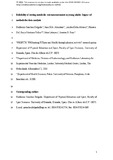Mostrar el registro sencillo del ítem
Reliability of resting metabolic rate measurements in young adults: impact of methods for data analysis
| dc.creator | Sánchez Delgado, Guillermo | es_ES |
| dc.creator | Alcántara Alcántara, Juan Manuel | es_ES |
| dc.creator | Ortiz Álvarez, Lourdes | es_ES |
| dc.creator | Xu, Huiwen | es_ES |
| dc.creator | Martínez Téllez, Borja | es_ES |
| dc.creator | Labayen Goñi, Idoia | es_ES |
| dc.creator | Ruiz, Jonatan R. | es_ES |
| dc.date.accessioned | 2019-08-09T07:27:38Z | |
| dc.date.available | 2019-10-01T23:00:16Z | |
| dc.date.issued | 2018 | |
| dc.identifier.issn | 1532-1983 | |
| dc.identifier.uri | https://hdl.handle.net/2454/34214 | |
| dc.description.abstract | Background and aims: a high inter-day reliability is a key factor to analyze the magnitude of change in resting metabolic rate (RMR) after an intervention, and the impact of using different methods for data analysis is not known. The aims of this study were: i) to analyze the impact of methods for data analysis on RMR and respiratory exchange ratio (RER) estimation; ii) to analyze the impact of methods for data analysis on inter-day RMR and RER reliability; iii) to compare inter-day RMR and RER reliability across methods for data analysis in participants who achieved steady state (SS) vs. participants who did not achieve SS. Methods: Seventeen young healthy adults completed two 30-min indirect calorimetry (IC) measures on two consecutive mornings, using two metabolic carts each day. Two methods for data analysis were used: i) Selection of a predefined time interval (TI) every 5 min (1-5 min, 6-10 min, 11-15 min, 16-20 min, 21-25 min, 26-30 min); and TI representing the whole measurement period (0-30 min, 5-30 min, 5-25 min); and ii) Methods based on the selection of the most stable period (SSt methods) (3 min SSt, 4 min SSt, 5 min SSt, 10 min SSt). Additionally, participants were classified as those achieving SS (CV < 10% for VO2, VCO2 and VE, and CV < 5% for RER) and those who did not. Results: RMR and RER measurements were lower when following SSt methods than when following TI methods (all P < 0.01). Although no significant differences were found between different lengths of SSt, 5 min SSt presented the lowest RMR. There were no differences on the inter-day reliability across methods for data analysis (TI and SSt) (all P > 0.2), and there was no systematic bias when comparing RMR and RER day 1 and day 2 measurements (all P > 0.1). Inter-day reliability was similar in individuals who achieved the SS and individuals who did not achieve it. The results were consistent independently of the metabolic cart used. Conclusions: The 5 min SSt approach should be the method of choice for analyzing IC measures with metabolic carts. However, achieving SS should not be an inclusion criterion in an IC study with young healthy adults. | en |
| dc.description.sponsorship | The study was supported by the Spanish Ministry of Economy and Competitiveness, Fondo de Investigación Sanitaria del Instituto de Salud Carlos III (PI13/01393), Fondos Estructurales de la Unión Europea (FEDER), by the Spanish Ministry of Education (FPU 13/04365 and 15/04059), by the Fundacion Iberoamericana de Nutrición (FINUT), by the Redes temáticas de investigación cooperativa RETIC (Red SAMID RD16/0022), by AstraZeneca HealthCare Foundation and by the University of Granada, Plan Propio de Investigación 2016, Excellence actions: Units of Excellence; Unit of Excellence on Exercise and Health (UCEES). | en |
| dc.format.extent | 29 p. | |
| dc.format.mimetype | application/pdf | en |
| dc.language.iso | eng | en |
| dc.publisher | Elsevier | en |
| dc.relation.ispartof | Clinical Nutrition, 37 (2018) 1618-1624 | en |
| dc.rights | © 2017 Elsevier Ltd and European Society for Clinical Nutrition and Metabolism. This manuscript version is made available under the CC-BY-NC-ND 4.0. | en |
| dc.rights.uri | http://creativecommons.org/licenses/by-nc-nd/4.0/ | |
| dc.subject | Resting energy expenditure | en |
| dc.subject | Indirect calorimetry | en |
| dc.subject | Steady state | en |
| dc.subject | Metabolic cart | en |
| dc.subject | CCM express | en |
| dc.subject | Ultima CardiO2 | en |
| dc.title | Reliability of resting metabolic rate measurements in young adults: impact of methods for data analysis | en |
| dc.type | info:eu-repo/semantics/article | en |
| dc.type | Artículo / Artikulua | es |
| dc.contributor.department | Ciencias de la Salud | es_ES |
| dc.contributor.department | Osasun Zientziak | eu |
| dc.rights.accessRights | info:eu-repo/semantics/openAccess | en |
| dc.rights.accessRights | Acceso abierto / Sarbide irekia | es |
| dc.embargo.terms | 2019-10-01 | |
| dc.identifier.doi | 10.1016/j.clnu.2017.07.026 | |
| dc.relation.publisherversion | https://doi.org/10.1016/j.clnu.2017.07.026 | |
| dc.type.version | info:eu-repo/semantics/acceptedVersion | en |
| dc.type.version | Versión aceptada / Onetsi den bertsioa | es |



